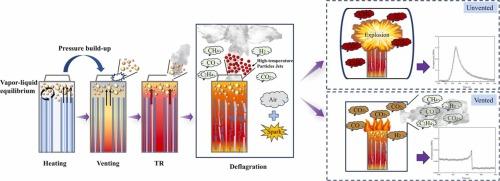Study on explosion venting efficacy of thermal runaway gases from lithium-ion batteries in a confined space: Impact of venting area
IF 7.8
2区 环境科学与生态学
Q1 ENGINEERING, CHEMICAL
引用次数: 0
Abstract
In thermal runaway (TR) incidents of lithium-ion battery (LIB) energy storage systems (ESSs), large quantities of toxic, flammable, and explosive gases are released. When these combustible gases accumulate in an enclosed space, they can easily trigger severe combustion and explosion events upon encountering an ignition source. Explosion venting is commonly employed as an effective measure to mitigate explosion hazards. This study investigated the TR explosion venting characteristics of 26700-type cells: a TR gas explosion experimental platform was constructed to trigger cell TR through electrical heating and ignite the released high-temperature gases, examining flame characteristics and explosion overpressure under different vent areas. Dimensionless coefficients and are used to quantify the venting capacity of the explosion vent. The research found that during the explosion venting process, the flame color transitions from initial yellow-white to red. After the flame front descends to the height of the vent, it transforms into oscillating flame. Three overpressure peaks occur inside the test chamber during the TR gas explosion of LIBs. The explosion overpressure can be reduced by more than 93 % through the installation of a vent in the 80 L test chamber. The dimensionless venting coefficient effectively characterizes the nonlinear relationship between vent area and explosion hazards: as decreases from 74.26 to 6.19, the average maximum overpressure peak drops from 27 kPa to 7.2 kPa, and the average deflagration index decreases from 220.73 kPam/s to 3.96 kPam/s. The venting efficiency is maximized when =8.25. This research verifies the effective protection of explosion vent design against TR gas explosions in LIBs and provides quantitative guidance for vent area design.

密闭空间锂离子电池热失控气体爆炸排气效果研究:排气面积的影响
在锂离子电池储能系统热失控事故中,会释放出大量有毒、易燃、易爆气体。当这些可燃气体在密闭空间内积聚时,遇到点火源时很容易引发严重的燃烧和爆炸事件。排爆是减轻爆炸危险的一种有效措施。本研究对26700型电池的TR爆炸放空特性进行了研究:搭建TR气体爆炸实验平台,通过电加热触发电池TR,点燃释放的高温气体,检测不同放空面积下的火焰特性和爆炸超压。采用无因次系数Kv和Ks来量化爆炸通风口的通风量。研究发现,在爆炸排气过程中,火焰颜色由最初的黄白色过渡到红色。火焰锋面下降到通风口高度后,转变为振荡火焰。在lib的TR气体爆炸过程中,试验室内出现了三个超压峰。通过在80l试验箱中安装通风口,可使爆炸超压降低93%以上。无因次通气系数Kv有效表征了通气面积与爆炸危险性之间的非线性关系:当Kv从74.26减小到6.19时,平均最大超压峰值从27 kPa减小到7.2 kPa,平均爆燃指数从220.73 kPa∙m/s减小到3.96 kPa∙m/s。当Kv =8.25时,排气效率最大。本研究验证了爆炸通风口设计对lib中TR气体爆炸的有效防护,为通风口区域设计提供了定量指导。
本文章由计算机程序翻译,如有差异,请以英文原文为准。
求助全文
约1分钟内获得全文
求助全文
来源期刊

Process Safety and Environmental Protection
环境科学-工程:化工
CiteScore
11.40
自引率
15.40%
发文量
929
审稿时长
8.0 months
期刊介绍:
The Process Safety and Environmental Protection (PSEP) journal is a leading international publication that focuses on the publication of high-quality, original research papers in the field of engineering, specifically those related to the safety of industrial processes and environmental protection. The journal encourages submissions that present new developments in safety and environmental aspects, particularly those that show how research findings can be applied in process engineering design and practice.
PSEP is particularly interested in research that brings fresh perspectives to established engineering principles, identifies unsolved problems, or suggests directions for future research. The journal also values contributions that push the boundaries of traditional engineering and welcomes multidisciplinary papers.
PSEP's articles are abstracted and indexed by a range of databases and services, which helps to ensure that the journal's research is accessible and recognized in the academic and professional communities. These databases include ANTE, Chemical Abstracts, Chemical Hazards in Industry, Current Contents, Elsevier Engineering Information database, Pascal Francis, Web of Science, Scopus, Engineering Information Database EnCompass LIT (Elsevier), and INSPEC. This wide coverage facilitates the dissemination of the journal's content to a global audience interested in process safety and environmental engineering.
 求助内容:
求助内容: 应助结果提醒方式:
应助结果提醒方式:


